A Brief History of Munich and 6 Modern Attractions - In Preparation for an Upcoming School Trip
Hello everyone! In a few weeks, I along with several other people from my school, will be traveling to Germany for 10 days. In preparation for that, I have decided to highlight some of the attractions and landmarks we might see. I intend to write posts about every branch of this trip (in a notebook during the trip, then into articles). Our first stop will be Munich, so let's get into some of the attractions we might see!
Munich History
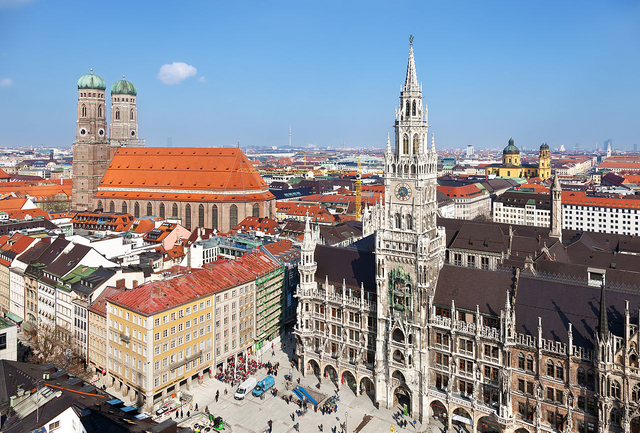 Source: Wikipedia, Licensed CC BY-SA 3.0 de
Source: Wikipedia, Licensed CC BY-SA 3.0 de
 Source: Wikipedia, Licensed CC BY-SA 3.0 de
Source: Wikipedia, Licensed CC BY-SA 3.0 deBrief History - Munich is currently the capital of Bavaria and the 3rd largest German city. Its origins lie as early as 750 A.D. with the Benedictine Monestary. In 1157 A.D. Henry the Lion granted the Monks the ability to build a market place.
In 1255 B.C. the famously successful Wittelsbach family moved to Munich. This would spark a connection between the family and the city that would last for nearly 700 years. Louis the Bavarian (Louis IV) would become the first Wittelsbach Holy Roman Emperor in the early 1500s. He became responsible for the expansion that built Munich up to the size it would remain at until the 18th century.
The next notable ruler, Maximilian I, brought the city wealth and prosperity until the Thirty Years' War. It was then occupied by the Swedish ruler Gustav II Adolf in 1632. By 1634, a plague had wiped out 1/3 of the city's population.
The next notable ruler was not until the 19th century with the rise of the third Wittelsbach to have a lasting effect on the city, Louis I. Louis I was responsible for expanding Munich to what it is in modern times.
After this, Munich began to see a large surge in prosperity. Protestants were allowed to take citizenship for the first time ever. The city experienced great prosperity, having its population Quintuple within fifty years. The ruler Louis II also brought the city a reputation for music and the stage by championing the very notable composer Richard Wagner. The Wittelsbach dynasty finally ended with the self-imposed exile of Louis II as a result of World War I. From here, Munich became a large breeding grounds for the rising Nazi party, who inducted their leader, Adolf Hitler, in Munich. Munich suffered greatly as a result of World War II, losing 40 percent of its buildings to Allied Bombing Raids.
Munich Now - Munich now specializes in Light Industry; producing precision instruments, optical and electrical appliances, and aerospace and other high-technology products. It also specializes in food production, cosmetics, clothing, and is famous for its Beer. Tourism is also a large contributor to the Munich economy.
Munich also functions as a major European hub, with rail connections to many of the major European cities and destinations.
The older part of town has seen an increase in businesses, becoming a business center, and losing much of its ancient perception.
6 Destinations in Munich
I am going to pick 6 attractions in Munich to research and describe them here:
6. Allianz Arena
 Source: Wikipedia, Licensed CC BY-SA 2.5
Source: Wikipedia, Licensed CC BY-SA 2.5
 Source: Wikipedia, Licensed CC BY-SA 2.5
Source: Wikipedia, Licensed CC BY-SA 2.5This is an entry which I am adding in several minutes after posting this because I realized that this is one of the noted places we are going. It is the worlds only stadium with a fully color changing exterior. The stadium was first conceptualized in 2002 when voters voted on whether or not they wanted a stadium to be built in the location (with government funding). About 2/3s of voters voted in favor. Construction then began in 2002, ending by 2005. Here is a video about the Stadium's use of LEDs:
5. Munich Residenz
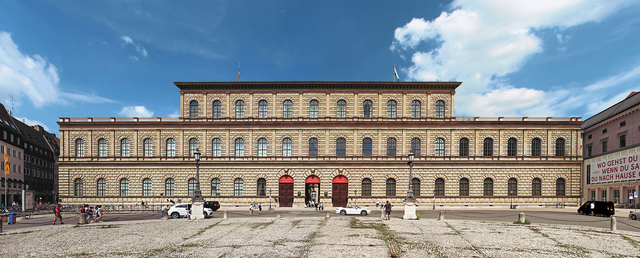 Source: Wikipedia, Licensed CC BY-SA 4.0
Source: Wikipedia, Licensed CC BY-SA 4.0
 Source: Wikipedia, Licensed CC BY-SA 4.0
Source: Wikipedia, Licensed CC BY-SA 4.0The Residenz was formerly the royal palace of the Wittelsbach family. It is currently the largest city palace in Germany, and is, as a result, a major tourist attraction. The Residenz is comprised of 10 courtyards as well as 130 rooms. It is comprised of three sections: the Königsbau (The King's Building), the Alte Residenz (The Old Residence), and the Festsaalbau (Banquet Hall).
The first of this site's buildings can be dated to around 1385. Construction on the Residenz began as a sanction for a failed rebellion. This castle was built to be sturdy and easy to defend (as opposed to the old court which had been very difficult to defend). It was built to be impregnable yet easy to leave located outside of the city. This was for two reasons, (1) the Dukes feared the ever apparent and easily stirred rebellious nature of the towns people (hence the impregnable design), and (2) the Dukes feared their warlike relatives (hence the easy to leave).
This architectural site can be observed to incorporate the styles of the Renaissance, as well as of the Baroque, Rococo and Neo-Classicism.
4. Englisch Garten (English Garden)
This is one attraction which I know we are visiting (due to the Itinerary). This is a large public park located at the center of Munich which stretches all the way to the city's Northeastern border. Its name comes from the style of informal landscaping it utilizes (popular in 18th century England).
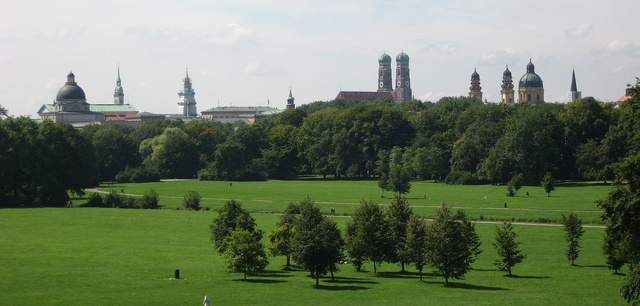 Source: Wikipedia, Licensed CC BY-SA 3.0
Source: Wikipedia, Licensed CC BY-SA 3.0
 Source: Wikipedia, Licensed CC BY-SA 3.0
Source: Wikipedia, Licensed CC BY-SA 3.0The Garden's origin story begins with the death of the last ruler from the Bavarian branch of the Wittelsbach dynasty, Maximilian III (who had no children). As a result of this, the crown passed to Charles Theodore. Theodore did not appreciate this inheritance because he would have to move from his home in Mannheim on the Rhine to Bavaria. He tried (and failed) to trade his inherited Bavaria for the Austrian Netherlands. After this trade backfired, you can imagine how the people of Bavaria reacted. In order to end his people's disdain, he focused on adding improvements to the city. One of these improvements was the creation of an art gallery in the Residence's Hofgarten's northern acres. He then opened these attractions to the public in 1780.
The actual Englisch Garten came at a different point though. Theodore had decided that in times of peace, it might be a good idea to have his soldiers work in agriculture and gardening. In 1789, Theodore decided to build a great public park, of which the military park would be a small part. He assigned the Royal Gardener Friedrich Ludwig Sckell, who had learned gardening from the English, to front the project.
3. Nymphenburg Palace
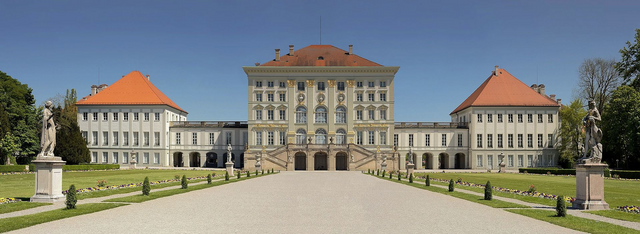 Source: Wikipedia, Licensed CC BY-SA 2.5
Source: Wikipedia, Licensed CC BY-SA 2.5
 Source: Wikipedia, Licensed CC BY-SA 2.5
Source: Wikipedia, Licensed CC BY-SA 2.5This was a baroque palace built by (yet again) the ruling family dynasty in Munich, the Wittelsbach family. In 1664, the palace was built by Ferdinand Maria and Henriette Adelaide utilizing the work of Italian architect Agostino Barell. It took over a century for the palace to be deemed completed, and renovations took place far into the 19th century.
The Nymphenburg palace was one of the Bavarian rulers' favorite summer locations. King Max I Joseph would die there in 1825, while King Ludwig II (famous for Neuschwanstein Castle) was born there in 1836.
2. Marienplatz
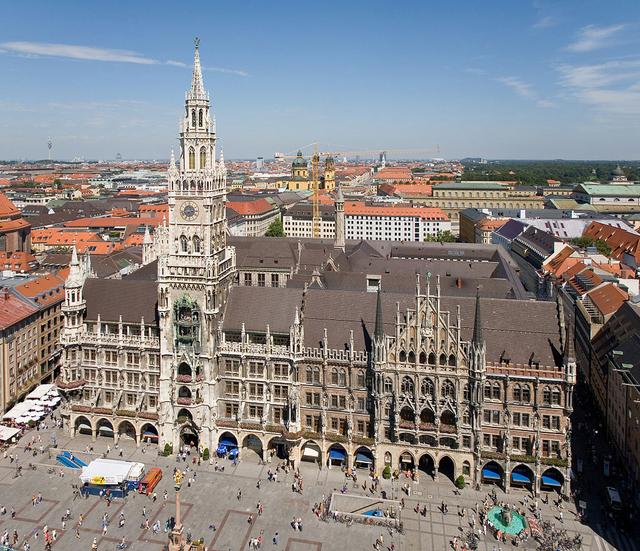 Source: Wikipedia, Licensed CC BY-SA 3.0
Source: Wikipedia, Licensed CC BY-SA 3.0
 Source: Wikipedia, Licensed CC BY-SA 3.0
Source: Wikipedia, Licensed CC BY-SA 3.0Marienplatz has held the role of Munich's city square since 1158. The square owes its name to the Mariensäule, a Marian column built to celebrate the end of Swedish Occupation in 1638. Today, visitors can see the Neues Rathaus (New City Hall) on the North side, and the Altes Rathaus (Old City Hall) to the East. The old city hall utilizes a Gothic style, and has been reconstructed.
In medieval times, tournaments would be held in this square, and it would host several varieties of significant markets. This area is also famous for the Christmas market it hosts every year starting three weeks prior to Christmas.
1. Hofbräuhaus München
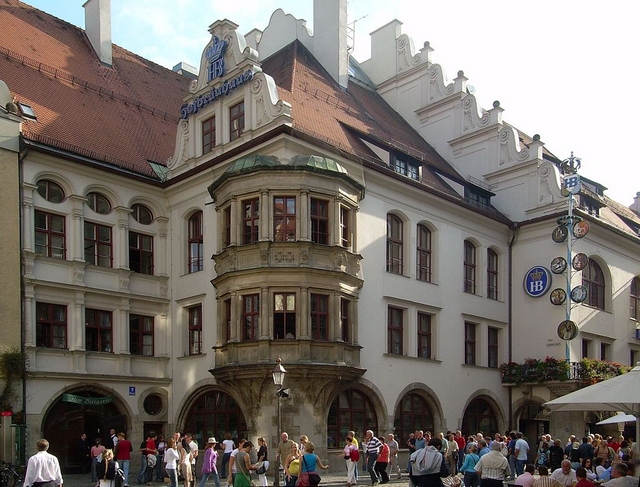 Source: Wikipedia, Licensed Public Domain
Source: Wikipedia, Licensed Public Domain
 Source: Wikipedia, Licensed Public Domain
Source: Wikipedia, Licensed Public DomainIf you like beer, the Hofbräuhaus München is where you'll want to visit. This Bavarian state owned beer hall has served as Munich's royal brewery for generations. It was founded in 1589 by the Duke of Bavaria, Wilhelm V, as the old Royal Residence's brewery.
Its fame grew after World War II, when American soldiers (previously stationed in Munich) came home wielding beer mugs with the Hofbräuhaus München. This accidental advertisement elevated Hofbräuhaus München to one of the most popular tourist destinations in Munich.
Sources
Information
- Encyclopedia Britannica (Munich History)
- Wikipedia (Allianz Arena)
- Wikipedia (Munich Residenz)
- Wikipedia (Englisch Garten)
- Wikipedia (Nymphenburg Palace)
- Wikipedia (Marienplatz)
- Wikipedia (Hofbräuhaus München)
Images
- Wikipedia (StadtbildMünchen - Thomas Wolf)
- Wikipedia (Allianz Arena - Maximilian Dörrbecker )
- Wikipedia (Munich Residenz, Königsbau - MagentaGreen)
- Wikipedia (Englisch Garten - Ludmiła Pilecka)
- Wikipedia (Nymphenburg Palace - Richard Bartz)
- Wikipedia (Marienplatz - Diliff)
- Wikipedia (Hofbräuhaus München - Public Domain)
Conclusion
Thanks to everyone who read this! I am excited about this trip, and will try to keep a journal of all of my initial observations! Today I really learned the significance of the Wittelsbach family. I felt like I was reading about the real life Starks of Winterfell :) Anyway, I hope you learned something from this article too!

(Note) In order to encourage meaningful feedback on the platform, I will check comment trails of users who leave superficial comments (ie "Awesome post," or "Upvoted.") and will mute any users who exhibit a pattern of leaving "spammy" comments.